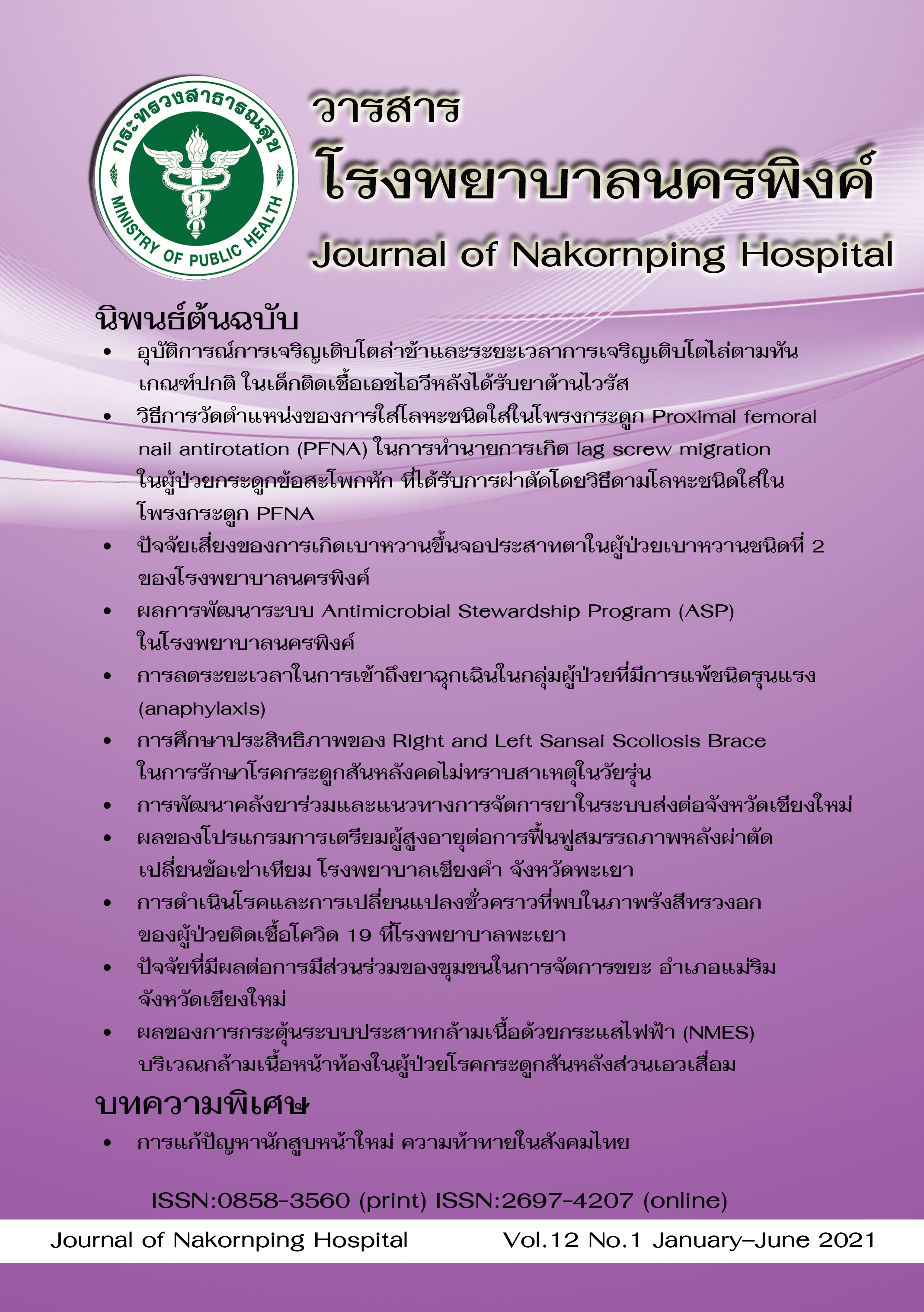Effect of Antimicrobial Stewardship Programme (ASP) Development in Nakornping Hospital
Keywords:
DDD, ASPAbstract
The strategy to drive the antimicrobial resistance management in Thailand is follow the “Global Action Plan on Antimicrobial Resistance. In Thailand: 2016-2021”. It was found that the antimicrobial consult forms were returned for expert consultant only 19.56 % in Nakornping Hospital. Therefore, the development of management by pharmacists has been performed for increasing the returning of consult form.
Objective: To study the effect of the developed ASP system on the returned rate of antimicrobial consult forms (ABO) and antimicrobial consumption.
Study design: Retrospective analytical study was used to collect the antimicrobial consult forms and the data from electronic data base of Nakornping Hospital. Only patients who admitted between 1 Octoble 2013 – 31 December 2019 were enrolled in this study. The antimicrobial cost, defined daily dose (DDD) and the effect of developed system, especially correlation between carbapenem and non-carbapenem by using multilevel mixed model.
Result of the study: The submission rate of ABO was increase from 19.65 % in 2017 to 44.93 % in 2018 and 46.32 % in 2019. The targeted drug cost was decreased between 2016- 2019 as 19.7, 17.5, 16.4 and 15.7 million baht, respectively. Comparing the usage of carbapenem with non-carbapenem, the effect on DDD of each drug was significantly reduced by 0.277 [95% CI, (-0.46) –
(-0.10),p= 0.002] in the period of 42 months. In bugget year (2019), analysed ABO form for 1,815 times. Docters agreed with the suggestion of expert 1,646 times (90.69%).
Conclusion: The system development of using ASP by pharmacist in Nakornping Hospital was increased the returning of the antimicrobial consult form, decreased the total of antimicrobial cost used and changed DDD of target drugs consumption, significantly.
References
สุณิชา ชานวาทิก, อังคณา เลขะกุล, วุฒิพันธ์ วงษ์มงคล, วลัยพร พัชรนฤมล, อภิชาต ธัญญาหาร, วิโรจน์ ตั้งเจริญเสถียร. สถานการณ์การใช้ยาต้านจุลชีพและความรู้เรื่องยาต้านจุลชีพ ข้อมูลจาการสำรวจอนามัยและสวัสดิการ พ.ศ.2560. วารสารวิจัยระบบสาธารณสุข.2561; (3): 421-436.
Pena C, Suarez C, Gozalo M, Murillas J, Almirante B, Pomar V, et al. Prospective multicenter study of the impact of carbapenem resistance on mortality in Pseudomonas aeruginosa bloodstream infections. Antimicrob Agents Chemother. 2012;56(3):1265-72.
ภูมาศ ภาณุมาศ, วิษณุ ธรรมลิขิตกุล, ภูษิต ประคองสาย, ตวงรัตน์ โพธะ, อาทร ริ้วไพบูลย์, สุพล ลิมวัฒนานนท์. ผลกระทบด้านสุขภาพและเศรษฐศาสตร์จากการติดเชื้อดื้อยาต้านจุลชีพในประเทศไทย : การศึกษาเบื้องต้น. วารสารวิจัยระบบสาธารณสุข. 2555;6(3):352-60.
งานควบคุมและป้องกันการติดเชื้อ. รายงานสรุปสถานการณ์ติดเชื้อดื้อยาที่ควบคุมพิเศษ แผนกศัลยกรรม 2561. เชียงใหม่: โรงพยาบาลนครพิงค์; 2561.
พรพิมล จันทร์คุณาภาส, ไพรำ บุญญะฤทธิ์, นุชน้อย ประภาโส, วรนัดดา ศรีสุพรรณ, ไพทิพย์ เหลืองเรืองรอง. แนวทางการจัดการการดื้อยาต้านจุลชีพในโรงพยาบาล. พิมพ์ครั้งที่1.นนทบุรี: กลุ่มงานพัฒนาระบบสนับสนุนบริการ สำนักบริหารการสาธารณสุข สำนักงานปลัดกระทรวงสาธารณสุข; 2559.
วิชัย สันติมาลีวรกุล, ปานรดา นวลโสภาภณ. การทบทวนการวัดผลลัพธ์การดำเนินงานของระบบสนับสนุนการใช้ยาต้านจุลชีพสมเหตุผล. วารสารเภสัชกรรมไทย. 2563;12(2):411-20.
มรกต อนันต์วัฒนกิจ. ผลของ Antimicrobial Stewardship Program ต่อความเหมาะสมของการใช้ยาต้านจุลชีพ [วิทยานิพนธ์ปริญญาเภสัชศาสตร์มหาบัณฑิต]. กรุงเทพฯ: จุฬาลงกรณ์มหาวิทยาลัย; 2557.
อรวรรณ โอษฐิเวช. ความชุกของเชื้อ Carbapenem Resistant Enterobacteriaceae ในโรงพยาบาลมุกดาหาร. วารสารวิชาการกรมสนับสนุนบริการสุขภาพ. 2563;16(2):47-56.
นฤมล ธูปสมพงศ์, ชมพิศ ศิริวงศ์. การประเมินการใช้ยาปฏิชีวนะกลุ่ม Restricted Antibiotics แผนกผู้ป่วยใน โรงพยาบาลพังงา. วารสารวิชาการแพทย์เขต 11. 2558;29(4):621-23.
Downloads
Published
How to Cite
Issue
Section
License
The articles that had been published in the journal is copyright of Journal of Nakornping hospital, Chiang Mai.
Contents and comments in the articles in Journal of Nakornping hospital are at owner’s responsibilities that editor team may not totally agree with.



